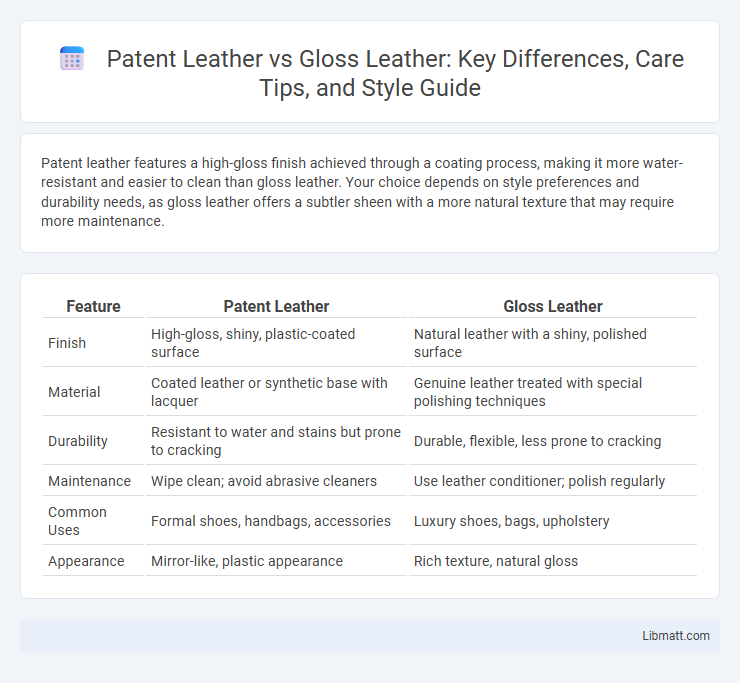Patent leather features a high-gloss finish achieved through a coating process, making it more water-resistant and easier to clean than gloss leather. Your choice depends on style preferences and durability needs, as gloss leather offers a subtler sheen with a more natural texture that may require more maintenance.
Table of Comparison
| Feature | Patent Leather | Gloss Leather |
|---|---|---|
| Finish | High-gloss, shiny, plastic-coated surface | Natural leather with a shiny, polished surface |
| Material | Coated leather or synthetic base with lacquer | Genuine leather treated with special polishing techniques |
| Durability | Resistant to water and stains but prone to cracking | Durable, flexible, less prone to cracking |
| Maintenance | Wipe clean; avoid abrasive cleaners | Use leather conditioner; polish regularly |
| Common Uses | Formal shoes, handbags, accessories | Luxury shoes, bags, upholstery |
| Appearance | Mirror-like, plastic appearance | Rich texture, natural gloss |
Understanding Patent Leather
Patent leather features a high-gloss finish achieved through a coating of lacquer or varnish, giving it a shiny, mirror-like appearance that is both water-resistant and durable. Unlike gloss leather, which is natural leather polished to a shine without additional coatings, patent leather's unique surface is less breathable but requires minimal maintenance to retain its glossy look. This makes patent leather a popular choice for formal footwear and accessories where a sleek, polished aesthetic is desired.
What is Gloss Leather?
Gloss leather is a type of leather treated with a glossy finish that enhances its natural texture while providing a shiny, reflective surface. Unlike patent leather, which has a thicker, plastic-like coating, gloss leather maintains breathability and flexibility due to a thinner, polished layer. This finish highlights the leather's grain and is often used in fashion for a sophisticated, sleek look without the high shine intensity of patent leather.
Key Differences: Patent vs. Gloss Leather
Patent leather features a high-gloss, shiny finish achieved through a coating process that makes it water-resistant and easy to clean, while gloss leather typically refers to smooth, polished leather with a natural shine enhanced by regular buffing or waxing. Patent leather's surface is uniform and reflective, often appearing plastic-like, whereas gloss leather retains the texture and breathability of the animal hide with a more subtle sheen. Understanding these key differences helps you choose between the dramatic, mirror-like appearance of patent leather and the understated elegance of gloss leather for your footwear or accessories.
Manufacturing Processes Compared
Patent leather is created by applying multiple layers of lacquer or plastic to a base leather, resulting in a high-gloss, mirror-like finish that is both durable and water-resistant. Gloss leather, on the other hand, is typically produced by polishing the leather surface with wax or synthetic coatings to achieve a shiny appearance without the thick coating typical of patent leather. Manufacturing patent leather involves a more complex curing process to ensure the glossy surface adheres properly, while gloss leather requires less intensive treatment focused on surface enhancement.
Appearance and Finish
Patent leather features a high-gloss, mirror-like finish achieved through the application of a lacquer or varnish, giving it a sleek, reflective appearance ideal for formal footwear and accessories. Gloss leather, while shiny, typically has a subtler sheen produced by polishing the leather surface, maintaining more natural texture and flexibility. The intense shine of patent leather contrasts with the more understated, polished look of gloss leather, influencing their suitability for different fashion styles and occasions.
Durability and Maintenance
Patent leather features a high-gloss finish achieved through a coating process that makes it resistant to water and stains, enhancing durability. Gloss leather, while also shiny, is typically finished with polishing techniques that may be less protective, requiring more frequent conditioning and careful cleaning to prevent cracking. Maintenance for patent leather is simpler due to its coated surface, whereas gloss leather demands regular care to maintain its shine and flexibility over time.
Common Uses in Fashion
Patent leather is widely used in fashion for formal footwear, handbags, and accessories due to its high-gloss, mirror-like finish that exudes elegance and sophistication. Gloss leather, featuring a shiny yet more natural sheen, is popular in both casual and dress shoes, as well as outerwear, offering versatility and a polished look without the rigidity of patent leather. Your choice between these materials depends on the desired level of shine and the formality of the occasion.
Price Comparison
Patent leather generally costs more than gloss leather due to its complex production process involving a high-gloss coating that provides a shiny, durable finish. Gloss leather, while still polished and visually appealing, often uses simpler treatments, making it more affordable and accessible for everyday use. Your choice between the two will depend on whether you prioritize luxury and sheen or budget-friendly style.
Pros and Cons of Patent Leather
Patent leather offers a highly glossy finish that enhances the aesthetic appeal of formal footwear and accessories, making your style stand out with a sleek, polished look. Its durable, water-resistant surface resists scuffs and stains better than gloss leather, but patent leather tends to be less breathable and can crack over time with improper care. While gloss leather provides more flexibility and a natural texture, patent leather's easy maintenance and striking shine are ideal for occasions requiring a refined, eye-catching appearance.
Pros and Cons of Gloss Leather
Gloss leather offers a sleek, shiny finish that enhances the visual appeal and makes shoes, bags, and jackets stand out in formal settings. Its main advantages include easy cleaning and resistance to water, but it is prone to visible scratches, creases, and less breathability compared to patent leather. Your choice depends on whether you prioritize durability and maintenance or a more refined, high-gloss aesthetic.
Patent leather vs gloss leather Infographic

 libmatt.com
libmatt.com